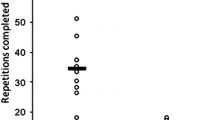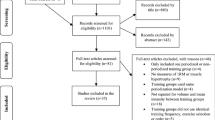Abstract
Resistance training is the most effective method to increase muscle mass. It has also been shown to promote many health benefits. Although it is deemed safe and of clinical relevance for treating and preventing a vast number of diseases, a time-efficient and minimal dose of exercise has been the focus of a great number of research studies. Similarly, an inverted U-shaped relationship between training dose/volume and physiological response has been hypothesized to exist. However, the majority of available evidence supports a clear dose-response relationship between resistance training volume and physiological responses, such as muscle hypertrophy and health outcomes. Additionally, there is a paucity of data to support the inverted U-shaped response. Although it may indeed exist, it appears to be much more plastic than previously thought. The overarching principle argued herein is that volume is the most easily modifiable variable that has the most evidenced-based response with important repercussions, be these muscle hypertrophy or health-related outcomes.
Similar content being viewed by others
References
You T, Arsenis NC, Disanzo BL, et al. Effects of exercise training on chronic inflammation in obesity: current evidence and potential mechanisms. Sports Med. 2013;43:243–56.
Ibañez J, Izquierdo M, Argüelles I, et al. Twice-weekly progressive resistance training decreases abdominal fat and improves insulin sensitivity in older men with type 2 diabetes. Diabetes Care. 2005;28:662–7.
Brooks N, Layne JE, Gordon PL, et al. Strength training improves muscle quality and insulin sensitivity in Hispanic older adults with type 2 diabetes. Int J Med Sci. 2006;4:19–27.
Hagerman FC, Walsh SJ, Staron RS, et al. Effects of high-intensity resistance training on untrained older men. I. Strength, cardiovascular, and metabolic responses. J Gerontol A Biol Sci Med Sci. 2000;55:B336–46.
Westcott WL. Resistance training is medicine: effects of strength training on health. Curr Sports Med Rep. 2012;11:209–16.
Aronow WS, Harrington RA, Fleg JL, et al. ACCF/AHA 2011 Expert consensus document on hypertension in the elderly. Circulation. 2011;123:2434–506.
Pescatello LS, Franklin BA, Fagard R, et al. American College of sports medicine position stand. Exercise and hypertension. Med Sci Sports Exerc. 2004;36:533–53.
American College of Sports Medicine. Progression models in resistance training for healthy adults. Med Sci Sport Exerc. 2009;41:687–708.
Williams MA, Haskell WL, Ades PA, et al. Resistance exercise in individuals with and without cardiovascular disease: 2007 update: a scientific statement from the American Heart Association Council on Clinical Cardiology and Council on Nutrition, Physical Activity, and Metabolism. Circulation. 2007;116:572–84.
Albright A, Franz M, Hornsby G, et al. American College of Sports Medicine position stand. Exercise and type 2 diabetes. Med Sci Sports Exerc. 2000;32:1345–60.
Gibala MJ. High-intensity interval training: a time-efficient strategy for health promotion? Curr Sports Med Rep. 2007;6:211–3.
Siddiqi Z, Tiro JA, Shuval K. Understanding impediments and enablers to physical activity among African American adults: a systematic review of qualitative studies. Health Educ Res. 2011;26:1010–24.
Heesch KC, Mâsse LC. Lack of time for physical activity: perception or reality for African American and Hispanic women? Women Health. 2004;39:45–62.
Thompson WR. Worldwide survey of fitness trends for 2017. ACSM’s Heal Fit J. 2016;20:8–17.
Gibala MJ, Little JP. Just HIT it! A time-efficient exercise strategy to improve muscle insulin sensitivity. J Physiol. 2010;588:3341–2.
Philippe AG, Py G, Favier FB, et al. Modeling the responses to resistance training in an animal experiment study. Biomed Res Int. 2015;2015:914860.
Schoenfeld BJ, Ogborn D, Krieger JW. Dose-response relationship between weekly resistance training volume and increases in muscle mass: a systematic review and meta-analysis. J Sports Sci. 2017;35:1073–108.
McBride JM, McCaulley GO, Cormie P, et al. Comparison of methods to quantify volume during resistance exercise. J Strength Cond Res. 2009;23:106–10.
Borde R, Hortobágyi T, Granacher U. Dose-response relationships of resistance training in healthy old adults: a systematic review and meta-analysis. Sports Med. 2015;45:1693–720.
Peterson MD, Rhea MR, Alvar BA. Applications of the dose-response for muscular strength development: a review of meta-analytic efficacy and reliability for designing training prescription. J Strength Cond Res. 2005;19:950–8.
Peterson MD, Rhea MR, Alvar BA. Maximizing strength development in athletes: a meta-analysis to determine the dose-response relationship. J Strength Cond Res. 2004;18:377–82.
Rhea MR, Alvar BA, Burkett LN, et al. A meta-analysis to determine the dose response for strength development. Med Sci Sport Exerc. 2003;35:456–64.
Krieger JW. Single versus multiple sets of resistance exercise: a meta-regression. J Strength Cond Res. 2009;23:1890–901.
Candow DG, Burke DG. Effect of short-term equal-volume resistance training with different workout frequency on muscle mass and strength in untrained men and women. J Strength Cond Res. 2007;21:204–7.
Tavares LD, de Souza EO, Ugrinowitsch C, et al. Effects of different strength training frequencies during reduced training period on strength and muscle cross-sectional area. Eur J Sport Sci. 2017;17:665–72.
Ahtiainen JP, Pakarinen A, Alen M, et al. Short vs. long rest period between the sets in hypertrophic resistance training: influence on muscle strength, size, and hormonal adaptations in trained men. J Strength Cond Res. 2005;19:572–82.
Schoenfeld BJ, Ratamess NA, Peterson MD, et al. Effect of different volume-equated resistance training loading strategies on muscular adaption in well trained men. J Sports Sci. 2014;28:2909–18.
Angleri V, Ugrinowitsch C, Libardi CA. Crescent pyramid and drop-set systems do not promote greater strength gains, muscle hypertrophy, and changes on muscle architecture compared with traditional resistance training in well-trained men. Eur J Appl Physiol. 2017;117:359–69.
Fink J, Schoenfeld BJ, Kikuchi N, et al. Effects of drop set resistance training on acute stress indicators and long-term muscle hypertrophy and strength. J Sports Med Phys Fitness. 2017. doi:10.23736/S0022-4707.17.06838-4.
Klemp A, Dolan C, Quiles JM, et al. Volume-equated high- and low-repetition daily undulating programming strategies produce similar hypertrophy and strength adaptations. Appl Physiol Nutr Metab. 2016;41:699–705.
Chestnut JL, Docherty D. The effects of 4 and 10 repetition maximum weight-training protocols on neuromuscular adaptations in untrained men. J Strength Cond Res. 1999;13:353–9.
Ribeiro AS, Schoenfeld BJ, Silva DRP, et al. Effect of two- versus three-way split resistance training routines on body composition and muscular strength in bodybuilders: a pilot study. Int J Sport Nutr Exerc Metab. 2015;25:559–65.
Conlon JA, Newton RU, Tufano JJ, et al. The efficacy of periodised resistance training on neuromuscular adaptation in older adults. Eur J Appl Physiol. 2017;117:1181–94.
Mangine GT, Hoffman JR, Gonzalez AM, et al. The effect of training volume and intensity on improvements in muscular strength and size in resistance-trained men. Physiol Rep. 2015;3:e12472.
Mitchell CJ, Churchward-Venne TA, West DWD, et al. Resistance exercise load does not determine training-mediated hypertrophic gains in young men. J Appl Physiol (1985). 2012;113:71–7.
de Salles BF, Simão R, Miranda F, et al. Rest interval between sets in strength training. Sports Med. 2009;39:765–77.
Willardson JM, Burkett LN. The effect of different rest intervals between sets on volume components and strength gains. J Strength Cond Res. 2008;22:146–52.
Schoenfeld BJ, Pope ZK, Benik FM, et al. Longer inter-set rest periods enhance muscle strength and hypertrophy in resistance-trained men. J Strength Cond Res. 2015;30:1805–12.
Buford TW, Kreider RB, Stout JR, et al. International Society of Sports Nutrition position stand: creatine supplementation and exercise. J Int Soc Sports Nutr. 2007;4:6.
Burke DG, Silver S, Holt LE, et al. The effect of continuous low dose creatine supplementation on force, power, and total work. Int J Sport Nutr Exerc Metab. 2000;10:235–44.
Vandenberghe K, Goris M, Van Hecke P, et al. Long-term creatine intake is beneficial to muscle performance during resistance training. J Appl Physiol (1985). 1997;83:2055–63.
Volek JS, Rawson ES. Scientific basis and practical aspects of creatine supplementation for athletes. Nutrition. 2004;20:609–14.
Chrusch MJ, Chilibeck PD, Chad KE, et al. Creatine supplementation combined with resistance training in older men. Med Sci Sports Exerc. 2001;33:2111–7.
Devries M, Phillips S. Creatine supplementation during resistance training in older adults—a meta-analysis. Med Sci Sports Exerc. 2014;46:1194–203.
Goto K, Nagasawa M, Yanagisawa O, et al. Muscular adaptations to combinations of high- and low-intensity resistance exercises. J Strength Cond Res. 2004;18:730–7.
Aguiar AF, Buzzachera CF, Pereira RM, et al. A single set of exhaustive exercise before resistance training improves muscular performance in young men. Eur J Appl Physiol. 2015;115:1589–99.
Hubal MJ, Gordish-Dressman H, Thompson PD, et al. Variability in muscle size and strength gain after unilateral resistance training. Med Sci Sports Exerc. 2005;37:964–72.
Churchward-Venne TA, Tieland M, Verdijk LB, et al. There are no nonresponders to resistance-type exercise training in older men and women. J Am Med Dir Assoc. 2015;16:400–11.
Ahtiainen JP, Walker S, Peltonen H, et al. Heterogeneity in resistance training-induced muscle strength and mass responses in men and women of different ages. Age (Dordr). 2016;38:10.
Montero D, Lundby C. Refuting the myth of non-response to exercise training: “non-responders” do respond to higher dose of training. J Physiol. 2017;11:3377–87.
Krieger JW. Single vs. multiple sets of resistance exercise for muscle hypertrophy: a meta-analysis. J Strength Cond Res. 2010;24:1150–9.
Peterson MD, Sen A, Gordon PM. Influence of resistance exercise on lean body mass in aging adults: a meta-analysis. Med Sci Sports Exerc. 2011;43:249–58.
Burd NA, Holwerda AM, Selby KC, et al. Resistance exercise volume affects myofibrillar protein synthesis and anabolic signalling molecule phosphorylation in young men. J Physiol. 2010;588:3119–30.
Terzis G, Spengos K, Mascher H, et al. The degree of p70 S6k and S6 phosphorylation in human skeletal muscle in response to resistance exercise depends on the training volume. Eur J Appl Physiol. 2010;110:835–43.
McKendry J, Pérez-López A, McLeod M, et al. Short inter-set rest blunts resistance exercise-induced increases in myofibrillar protein synthesis and intracellular signalling in young males. Exp Physiol. 2016;101:866–82.
Hackett DA, Johnson NA, Chow C-M. Training practices and ergogenic aids used by male bodybuilders. J Strength Cond Res. 2013;27:1609–17.
Correa CS, Teixeira BC, Cobos RCR, et al. High-volume resistance training reduces postprandial lipaemia in postmenopausal women. J Sports Sci. 2015;33:1890–901.
Law TD, Clark LA, Clark BC. Resistance exercise to prevent and manage sarcopenia and dynapenia. Annu Rev Gerontol Geriatr. 2016;36:205–28.
Wernbom M, Augustsson J, Thomeé R. The influence of frequency, intensity, volume and mode of strength training on whole muscle cross-sectional area in humans. Sports Med. 2007;37:225–64.
Ostrowski KJ, Wilson GJ, Weatherby R, et al. The effect of weight training volume on hormonal output and muscular size and function. J Strength Cond Res. 1997;11:148–54.
Amirthalingam T, Mavros Y, Wilson GC, et al. Effects of a modified German volume training program on muscular hypertrophy and strength. J Strength Cond Res. 2016. doi:10.1519/JSC.0000000000001747.
Strasser B, Siebert U, Schobersberger W. Resistance training in the treatment of the metabolic syndrome: a systematic review and meta-analysis of the effect of resistance training on metabolic clustering in patients with abnormal glucose metabolism. Sports Med. 2010;40:397–415.
Umpierre D, Ribeiro PAB, Schaan BD, et al. Volume of supervised exercise training impacts glycaemic control in patients with type 2 diabetes: a systematic review with meta-regression analysis. Diabetologia. 2013;56:242–51.
Grøntved A, Rimm EB, Willett WC, et al. A prospective study of weight training and risk of type 2 diabetes mellitus in men. Arch Intern Med. 2012;172:1306–12.
Grøntved A, Pan A, Mekary RA, et al. Muscle-strengthening and conditioning activities and risk of type 2 diabetes: a prospective study in two cohorts of US women. PLoS Med. 2014;11:e1001587.
Shad BJ, Thompson JL, Breen L. Does the muscle protein synthetic response to exercise and amino acid-based nutrition diminish with advancing age? A systematic review. Am J Physiol Endocrinol Metab. 2016;311:E803–17.
Phillips SM, Glover EI, Rennie MJ. Alterations of protein turnover underlying disuse atrophy in human skeletal muscle. J Appl Physiol. 1985;2009(107):645–54.
Faigenbaum AD, Myer GD. Resistance training among young athletes: safety, efficacy and injury prevention effects. Br J Sports Med. 2010;44:56–63.
Author information
Authors and Affiliations
Corresponding author
Ethics declarations
Funding
No sources of funding were used to assist in the preparation of this article.
Conflict of Interest
Vandré Casagrande Figueiredo, Belmiro Freitas de Salles and Gabriel Trajano declare that they have no conflicts of interest relevant to the content of this review.
Rights and permissions
About this article
Cite this article
Figueiredo, V.C., de Salles, B.F. & Trajano, G.S. Volume for Muscle Hypertrophy and Health Outcomes: The Most Effective Variable in Resistance Training. Sports Med 48, 499–505 (2018). https://doi.org/10.1007/s40279-017-0793-0
Published:
Issue Date:
DOI: https://doi.org/10.1007/s40279-017-0793-0




